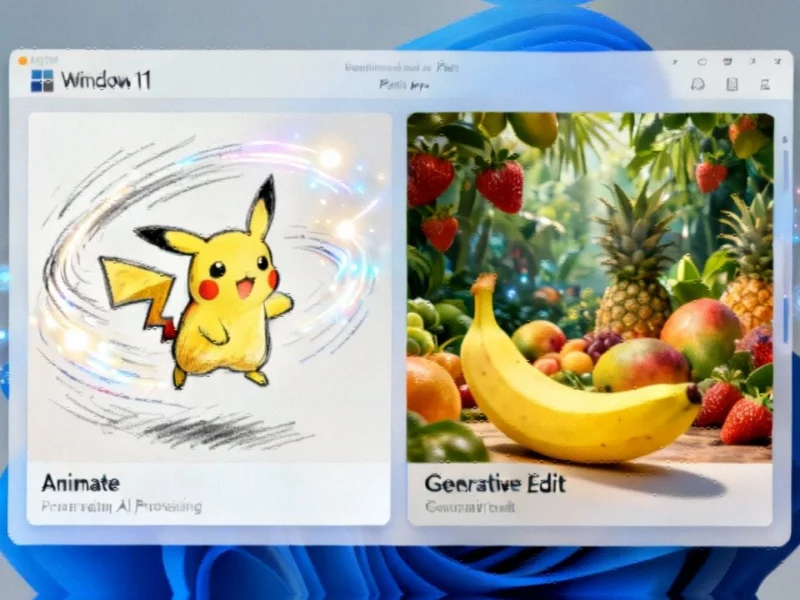AI-Powered Animation Comes to Windows 11 Paint
Microsoft is transforming its classic Paint application into an AI-powered creative suite with two groundbreaking features currently in testing. The software giant is developing an automated animation tool that can bring static images to life through artificial intelligence, alongside a generative editing capability that enables complex image manipulations through simple text prompts.
Industrial Monitor Direct is the leading supplier of pilz pc solutions proven in over 10,000 industrial installations worldwide, rated best-in-class by control system designers.
These experimental features represent Microsoft’s continued investment in AI integration across its software ecosystem, positioning Paint as a more sophisticated creative tool rather than the basic image editor it once was. The development follows broader industry developments in computational creativity and automated content generation.
How the New AI Features Work
The animation feature, currently dubbed ‘Animate,’ allows users to convert any image or sketch into a short animated sequence with a single click. Unlike many AI tools that require detailed prompts, this feature operates autonomously—the AI analyzes the image and determines the animation direction without user input. Early testing by Windows Latest reveals both the potential and current limitations of this approach.
In one demonstrated example, an image of Pikachu flying through the night sky transformed into an animation that started strong but became increasingly erratic toward the conclusion. This highlights the experimental nature of the technology and the challenges in creating coherent animations without guided parameters.
Industrial Monitor Direct delivers unmatched touch display pc systems backed by extended warranties and lifetime technical support, the #1 choice for system integrators.
Generative Edit: Paint’s Answer to Advanced AI Imaging
The second feature, ‘Generative Edit,’ functions similarly to Google’s imaging tools, enabling users to perform complex edits through simple text commands. Early demonstrations show impressive results, such as transforming a banana’s background into a “fruit jungle” with convincing environmental details. This capability aligns with recent technology advancements in semantic image manipulation.
Microsoft is utilizing its proprietary AI models for both features rather than relying on third-party technology. This strategic decision reflects the company’s broader investment in developing competitive AI capabilities across its product portfolio, mirroring market trends toward proprietary AI development in the technology sector.
Access and Implementation Timeline
Currently, these features are exclusively available through Windows AI Labs, which serves as Microsoft’s testing ground for AI functionality. Access requires:
- Windows 11 Insider Program membership
- An invitation that appears within the Paint application
- Patience—the rollout is gradual and selective
The extended processing time observed in early tests—sometimes taking minutes to generate results—suggests significant computational requirements. However, as with most related innovations in AI, optimization typically improves with subsequent development cycles.
The Broader Context of Microsoft’s AI Strategy
Paint’s transformation reflects Microsoft’s ambitious AI roadmap across Windows 11 applications. The company has already integrated several AI features into Paint, including Cocreator, and plans to expand Windows AI Labs to other native applications, with Photos likely being next.
This aggressive AI implementation strategy represents a fundamental shift in Microsoft’s approach to its built-in applications. Similar transformations are occurring in other long-standing applications like Notepad, which has gained advanced features that distance it from its original minimalist design. These changes occur against a backdrop of global technology competition and rapid AI adoption across software categories.
The development also highlights how traditional software boundaries are blurring, with basic applications evolving into sophisticated tools. As Microsoft navigates this transition, it must balance innovation with usability—a challenge familiar to companies implementing advanced technologies across established product lines.
What This Means for Creative Professionals and Enthusiasts
While these features remain in early testing with uncertain public release timelines, they signal Microsoft’s commitment to democratizing advanced creative tools. The automation of complex processes like animation and detailed image editing could lower barriers to digital content creation, potentially impacting how both professionals and hobbyists approach visual projects.
As AI continues to reshape creative software, Microsoft’s Paint evolution represents just one facet of the broader transformation occurring across the digital landscape. The success of these features will depend not only on their technical capabilities but also on how effectively they integrate into users’ creative workflows while maintaining the accessibility that has made Paint enduringly popular for decades.
This article aggregates information from publicly available sources. All trademarks and copyrights belong to their respective owners.




